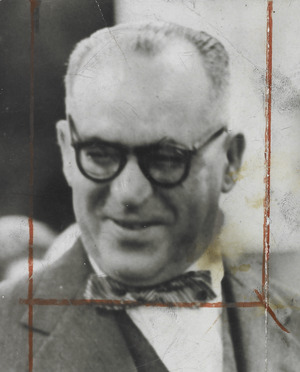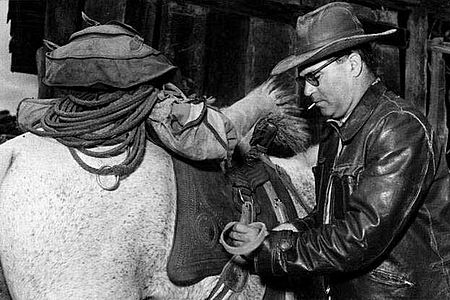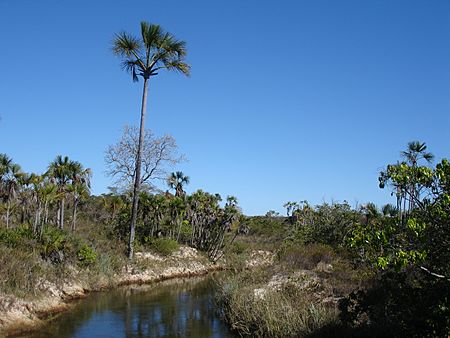João Guimarães Rosa facts for kids
Quick facts for kids
João Guimarães Rosa
|
|
|---|---|
 |
|
| 3rd Academic of the 2nd chair of the Brazilian Academy of Letters | |
| In office 16 November 1963 – 19 November 1967 |
|
| Preceded by | João Neves da Fontoura |
| Succeeded by | Mário Palmério |
| Personal details | |
| Born | 27 June 1908 Cordisburgo, Minas Gerais, Brazil |
| Died | 19 November 1967 (aged 59) Rio de Janeiro, Guanabara, Brazil |
| Alma mater | Federal University of Minas Gerais |
| Occupation | Author, novelist, short story writer |
| Profession | Diplomat |
João Guimarães Rosa (born June 27, 1908 – died November 19, 1967) was a famous Brazilian novelist, short story writer, poet, and diplomat. A diplomat is someone who represents their country in other nations.
Rosa wrote only one novel, Grande Sertão: Veredas. In English, it's known as The Devil to Pay in the Backlands. This book was very new and exciting for its time. It mixed old-fashioned words with everyday language. It also used many neologisms, which are newly invented words. Rosa got ideas for his language from the way people spoke in the Brazilian countryside, called the sertão.
Critics like Antonio Candido called the book a "metaphysical novel." This means it explored deep ideas about life and existence. Many people think it's Brazil's answer to Ulysses by James Joyce. In 2002, "Grande Sertão: Veredas" was even named one of the top 100 books of all time.
Rosa also published four books of short stories during his life. All of them were about life in the sertão. But they also talked about big ideas that are important in all literature. He passed away in 1967 from a heart attack. This was the same year he was nominated for the Nobel Prize in Literature.
Biography
João Guimarães Rosa was born in Cordisburgo, a town in the state of Minas Gerais, Brazil. He was the first of six children. From a young age, he loved learning. He taught himself many things and studied several languages. He started learning French before he was seven years old!
As a child, he moved to Belo Horizonte to live with his grandparents. There, he finished primary school. He started high school in São João del-Rei. But he soon returned to Belo Horizonte and finished his studies there. In 1925, when he was just 16, he began studying medicine. He went to the College of Medicine at the Federal University of Minas Gerais.
On June 27, 1930, he married Lígia Cabral Penna. She was sixteen years old. They had two daughters together, Vilma and Agnes. That same year, he graduated from medical school. He started working as a doctor in Itaguara. He stayed there for almost two years. In this town, Rosa first experienced life in the sertão.
During a conflict in 1932, Guimarães Rosa worked as a volunteer doctor. He helped soldiers in Passa-Quatro, Minas Gerais. There, he met Juscelino Kubitschek, who later became president of Brazil. Kubitschek was also a doctor at the time. Rosa later said that his experiences as a doctor and a soldier helped him become a writer.
In 1934, Rosa began his career as a diplomat. In 1938, he worked as an assistant-consul in Hamburg, Germany. There, he met his second wife, Aracy de Carvalho Guimarães Rosa. She was a very brave woman. She helped many Jews escape from the Third Reich during World War II. For her actions, she was given the title of Righteous among the nations. This is a special honor for non-Jewish people who risked their lives to save Jews during the Holocaust.
In 1963, he was chosen to join the Brazilian Academy of Letters. This is a very important group of writers and scholars in Brazil. He had been nominated before. He waited four years to accept his position. He finally joined in 1967. Just three days later, he passed away in Rio de Janeiro from a heart attack. He was at the peak of his career as both a diplomat and a writer.
Major Works
Sagarana
Guimarães Rosa first started writing poetry. But his book of poems, "Magma," was only published after he died. He began his writing career by entering a contest in 1938. He submitted a collection of twelve short stories. The famous writer Graciliano Ramos was one of the judges. Ramos did not give him first prize. He thought the stories were good but needed more work.
Rosa spent a lot of time improving his stories. He finally felt they were ready in 1946. This collection became known as Sagarana. Rosa's writing style was very different from Ramos's. Ramos wrote in a short, direct way. Rosa's writing was full of details and rich language. He used many words and explored the grammar of the Portuguese language in new ways.
The word "Sagarana" is a mix of two words: "saga" (meaning a long story) and "rana" (a word from the Tupi language meaning "in the manner of"). So, "Sagarana" means "stories in the manner of folk legends." The book has nine short stories. They all take place in the sertão. Many of them are about the jagunço. A jagunço was a type of armed guard or mercenary who worked for farmers in the Brazilian countryside. Rosa showed these characters as brave people with strong beliefs.
Rosa used many regional details from the sertão in his stories. He used the dialect (way of speaking) of the sertanejos, who are the people living in the sertão. He also included their traditions and customs. He used the geography and wildlife of the sertão to help tell his stories. He described landscapes and animals, like birds and cattle. These descriptions helped show the feelings of loneliness and the search for deeper meaning in life.
One famous story in Sagarana is O Burrinho Pedrês ("The Brindled Donkey"). In this story, Rosa used the sounds of words to create a feeling. He made the sentences sound like the traditional songs of the sertão. He also used onomatopoeia (words that sound like what they mean) and alliteration (repeating sounds). This helped to recreate the sounds of passing herds of cattle.
The most famous story in the collection is A Hora e Vez de Augusto Matraga (“The Time and Turn of Augusto Matraga”). Rosa called it a "key" to the whole collection. It tells the story of Augusto Esteves, a wealthy farmer. He was a very bad person. He was betrayed and beaten almost to death. He was left alone in the deserted countryside. Two old sertanejos rescued him. A priest told him that everyone has a special moment to find salvation. Augusto decided to become a good person. He worked hard on the farm and did good deeds. He became friends with a jagunço leader. Augusto wanted to go to heaven. He fought against injustice and became a saint-like figure.
Corpo de Baile
Guimarães Rosa's next book was Corpo de Baile (meaning "Corps de Ballet"). It was published ten years later, in 1956. Later, this collection was divided into three parts. These parts are usually published separately now. The original book was very complex. The title "corps de ballet" refers to the way ideas and symbols appear again and again in the stories. They "dance" around, gaining new meanings each time.
One important story in this collection is Recado do Morro ("Message from the Hills"). It talks about the idea of a special language of the sertão itself. In the story, a group of five sertanejos are traveling with a German scientist. They are exploring the state of Minas Gerais. As they travel, a message is passed along by different people. It starts with a madman who lives in caves. He tells it to his brother, who tells it to a child. The child tells it to a guide, who tells it to a hermit. The hermit tells it to a crowd in a city. Finally, a nervous man tells it to a poet and singer named Laudelim.
Each time the message is told, it changes a little. The poet finally turns it into a mythical song. He sings it at a party where the travelers are present. It becomes clear that the message was a warning for their leader, Pedro Orósio. Pedro was a strong man, but he was disliked by some. When he heard the song, Pedro understood its hidden meaning. He realized it was about him and his men. Because of this warning, he was able to save his life.
Rosa used this story to show how he saw his own writing. He mixed descriptions of nature with the changing versions of the story. He showed how people who are simple or "mad" can understand something special from nature. This understanding becomes clear through poetry. This is different from a scientific discovery of the sertão, which might not reveal its true secrets.
Grande Sertão: Veredas
Rosa published his most famous work, Grande Sertão: Veredas, in the same year. This was his only novel. It started as a short story but grew much larger. The book is written as a long monologue (a speech given by one person to themselves or an imagined listener). The speaker is a jagunço named Riobaldo. He tells his life story to an educated person from the city.
Riobaldo talks about the wars of the jagunços. This forms the main part of the story. But he also shares his thoughts on life, whether God and the Devil exist, and the nature of human feelings. He also talks about time and memory. He tells many short anecdotes (short, interesting stories). These stories are often allegories, meaning they have a hidden meaning that illustrates a point.
The book can be seen as a version of the faustian motif (a story where someone makes a deal with the Devil) set in the sertão. Riobaldo often returns to his main question: Does the Devil, and therefore evil, truly exist? Riobaldo is worried that he might have made a pact with the Devil. But he is not sure. He often dismisses the beliefs of the sertanejos as silly.
Riobaldo is also torn between two different kinds of love. He loves Diadorim, another jagunço. He calls this a "demonic love." He also loves Otacília, a beautiful woman from the countryside. He sees this as a "godly love" for peaceful times. He spends most of his life with Diadorim. But he only marries Otacília after his days as a jagunço are over.
Diadorim's identity is a big part of the story. Diadorim is actually a woman. But she pretends to be a man named Reinaldo. She does this to join the jagunços, which was a male-only world. Riobaldo only finds out her true gender after she dies. This shows a common idea in Riobaldo's thoughts: that things are always changing. Nothing stays the same. He often uses examples from nature, like poisonous rocks hidden in a clear river. Or he tells stories of good people becoming bad, and bad people becoming good.
The novel can also be seen as an attempt to remember things that are lost. It tries to give personal meaning to those memories. Reality, in the book, is built through language and the interaction between two people. The novel ends with the sentence: “Travessia. O homem humano.” (“Crossing. The human human-being.”). This is followed by the symbol of infinity, showing that life and its stories never truly end.
Later Works
After Grande Sertão: Veredas, Rosa published Primeiras Estórias (“First Stories”) in 1962. This collection had twenty-one short stories. One very famous story from this book is A Terceira Margem do Rio (meaning “The Third Bank of the River”). This story was made into a film and inspired a song by Caetano Veloso. The story is about a man who decides to live in a boat in the middle of a river. He gives no reason for his actions.
His last collection published while he was alive was Tutameia – Terceiras Estórias (“Tutameia – Third Stories”). The word “tuttameia” is a new word Rosa made up. It means "something of low value."
Two books were published after he died. These were Estas Estórias (“These Stories”), another collection of short stories. The other was ‘’Ave, Palavra’’ (which can mean “Bird, Word” or “Hail, Word”). This book was a mix of short stories, poems, journal entries, and travel notes.
See also
 In Spanish: João Guimarães Rosa para niños
In Spanish: João Guimarães Rosa para niños



